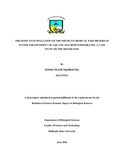Please use this identifier to cite or link to this item:
https://cris.library.msu.ac.zw//handle/11408/2553| Title: | The effects of pollution on the physico-chemical parameters of water and diversity of aquatic macroinvertebrates: a case study of the Khami dam. | Authors: | Dondo, Peter Nqobizitha | Keywords: | Industrial effluent | Issue Date: | Jun-2016 | Publisher: | Midlands State University | Abstract: | The impact of industrial effluent discharged into Khami Dam was assessed through physicochemical parameters and also by bio-monitoring of benthic macro-invertebrates. Samples for physico-chemical parameters were measured at three sites over a period of six months andsampling was done once each month. Composite samples of 1000ml for nitrates and phosphateswere collected using a beaker on all sites and placed on schott bottles and placed on ice filled cooler boxes and were then taken to the laboratory and refrigerated at (< 4 oC) for analysis using a Hach spectrophotometer (DR010 Hach Co, Loveland, Colorado, USA). Temperature was measured using a mercury bulb thermometer at the dam; the bulb was placed in the water and allowed to stand for 5 minutes and the recordings were taken. pH was measured using a Mettler Toledo 320 pH meter at the dam, the probe was placed in the water for 5 minutes and the readings were taken. An oxygen meter was used to measure the amount of dissolved oxygen at the dam, the probe was allowed to stand for 5 minutes and results were taken. A Mettler Toledo MC 226 conductivity meter was used to measure conductivity at the dam, the conductivity probe was allowed to stand for 10 minutes and results were taken. Total Dissolved Solids (TDS) were measured using the filter paper method where a volume 1000ml of composite sample was filtered using a filter paper and allowed to dry for 5 days at room temperature. Turbidity levels were measured using the Hach 2100A turbidity meter at the dam, that is, the probe was allowed to settle for 5 minutes and the readings were recorded. The Shannon-Wienner and Evenness indices were used to assess the health of the dam using aquatic macroinvertebrates as indicators of pollution. The highest diversity was observed at site 1 (reference point) having the highest value (1.957) and the least was at site 2 (middle point of the dam) with a value of (1.705). High levels of chemical pollutants were recorded at sites 2 and 3 (ZINWA red category) whereas site 1 (reference site) consisted of relatively clean water (ZINWA blue category). All the physical and chemical parameters were measured at selected sites on the dam and were analysed using one way anova. There were no significant differences for pH (p > 0.05), pH ranged from 8.4 to ± 8.2 units. For conductivity there were significant differences (p < 0.05) conductivity ranged from 487 to ± 160µScm-1. As for oxygen there were significant differences (p < 0.05) oxygen ranged from 7.8 to ± 5.7 mgL-1, whilst temperature showed no significant differences (p > 0.05) temperature ranged from 30.32 to ±27.88 0C. There were significant differences of TDS amongst the sites (p < 0.05) conductivity ranged from 576 to ±105 ppm. Phosphates ranged from 10.65 to ±0.1 mgL-1 as a result there were no significant differences amongst the sites (anova p < 0.05); however nitrates ranged from 2.07 to ± 0.01mgL-1 therefore there were significant differences. Turbidity ranged from 0.5 to ±0 NTU; hence there were significant differences amongst the sites (p < 0.05). These were compared with the standards set by ZINWA for waste water. The results of the study showed that there was a high degree of pollution on the Khami Dam and recommendations on reduction of pollution in the dam should be made. Sources of water pollution included effluents from industries, sewage and agricultural practices by the nearby farmers. | URI: | http://hdl.handle.net/11408/2553 |
| Appears in Collections: | Bsc Biological Sciences Honours Degree |
Files in This Item:
| File | Description | Size | Format | |
|---|---|---|---|---|
| THE EFFECTS OF POLLUTION ON THE PHYSICO (COMBINED).pdf | Full Text | 1.08 MB | Adobe PDF |  View/Open |
Page view(s)
230
checked on Dec 7, 2025
Download(s)
210
checked on Dec 7, 2025
Google ScholarTM
Check
Items in MSUIR are protected by copyright, with all rights reserved, unless otherwise indicated.



